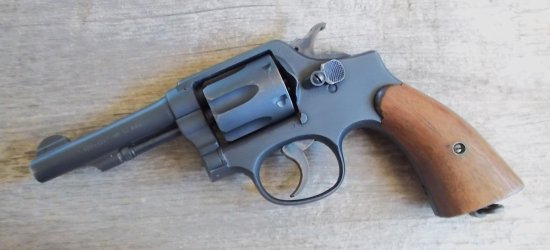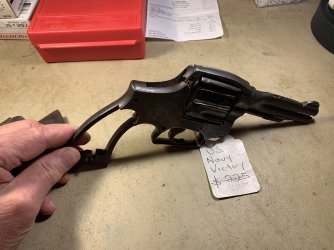When the U.S. Navy discovered that a dropped Victory revolver could discharge, they enjoined Smith & Wesson to make them safer in that regard. The company responded by revising the existing lockwork to incorporate a hammer block, and by the beginning of 1945 this became standard for ongoing production, the serial number prefix shifting from "V" to "SV" to identify the latest modified version. I believe this would've begun to occur somewhere in the early 700000 range, although I wouldn't be surprised if there was a considerable overlap in the serial number sequence between the two types. This improvement was retained when after the war the company resumed manufacture of commercial M&P's (initially making use of leftover, unfinished "SV" Victory frames).
The gun shown here is a somewhat different animal, having been originally shipped in mid-1943 and subsequently returned to S&W to be retrofitted with the hammer block. In this process, it gained an "S" stamped ahead of the existing "V" and so far as I can tell, was in addition otherwise thoroughly refurbished as well. The factory's output of brand new "SV" Victory revolvers during the waning months of the war evidently greatly exceeded the quantity of these earlier guns being updated by S&W.
The gun shown here is a somewhat different animal, having been originally shipped in mid-1943 and subsequently returned to S&W to be retrofitted with the hammer block. In this process, it gained an "S" stamped ahead of the existing "V" and so far as I can tell, was in addition otherwise thoroughly refurbished as well. The factory's output of brand new "SV" Victory revolvers during the waning months of the war evidently greatly exceeded the quantity of these earlier guns being updated by S&W.






